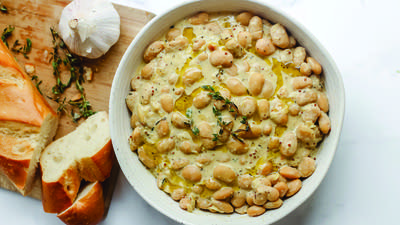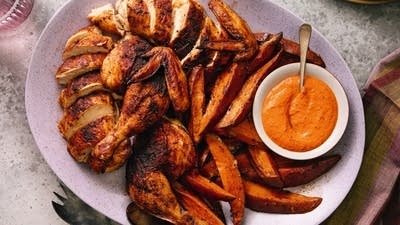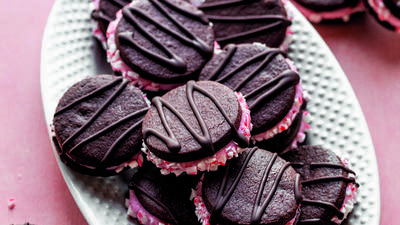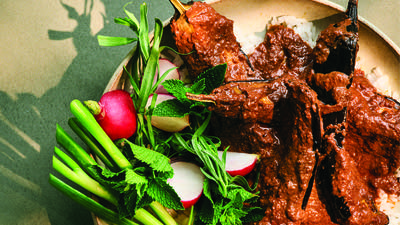
Charlotte Druckman has written the book on baking with cast iron--literally. She tells Melanie Dunea about the roles size, age, seasoning, and heat all play in the process.
Melanie Dunea: What is up with you and cast iron?
 Charlotte Druckman
Photo: Melanie Dunea
Charlotte Druckman
Photo: Melanie Dunea
Charlotte Druckman: My history with cast iron is actually short. I took a crash course to write this book, and now I love it, I'm obsessed with it, and I've inadvertently begun collecting it. I think it is the most versatile cooking material that you can use in your kitchen, and I think it's especially good for home cooks. This book was meant to highlight the baking side of it, which is the side that people don't think about as much. It's such a good baking vessel.
MD: It's true. I feel like this is an extension of the baking sheet.
CD: It is, but it gets hotter and it has slightly higher sides, so you get those beautifully caramelized edges and crispiness. I liken it to searing savory food as you would a steak. When you want to make perfect brownies, you're essentially trying to get the equivalent of a sear on your brownie; you want that good crust, but you also want them melty and almost raw inside.
With a skillet, once you get the hang of the timing because it gets very hot and stays very hot, you can nail things like brownies, cookies, and things where you want that soft, gooey middle with a nice crust.
MD: Let me get some details on this cast iron thing. Does size matter?
CD: It does, but it doesn't matter in terms of how you treat the pan. You treat the pan the same no matter how big or small it is. In terms of size, it's more about how many people you're feeding and the kinds of things you're getting done. Everything was done on a 10-inch cast-iron skillet for the book, and I think that's perfect for baking. If you're using it to make meals and you have a family of four, I would say you want a 12-inch. I recommend people having a 10-inch and a 12-inch. A 10-inch skillet will feed two people a meal; a 12-inch, four.
MD: What about old versus new?
CD: This is the thing where I get myself in trouble because we don't all have access to old pans. My mother threw out her old cast-iron pans, which means she has a bunch of semi-new pans and I have no heirlooms. To do this book, I got some vintage pans because I wanted to know what it was like to cook on new cast iron and old cast iron. It is such a dream to work on vintage cast iron that's been cared for, and it's relatively easy to fix up an old piece. They get this beautiful, smooth patina; it almost looks like poured chocolate.
But we don't all have access to that. People are making new pans, and Lodge is probably the most accessible. It's $15 for a 10-inch Lodge, and they come pre-seasoned. Lodge used to make pans back when cast iron was really this great American export, and they're the only remaining company that still makes them. They've changed the formula a bit, so I still think the vintage ones are better.
That said, you can do everything on the ones they're making now, and they're pretty easy to treat. You've got a few companies, like Finex in Portland, where they studied cast iron like it was a thesis. The owner, Mike White, had collected all of this cast iron, he became obsessed with it, and then he melted it down to make all of these prototypes. Now they're making these beautiful pans, and they're more expensive, but they're the kinds of pans that you will keep and then pass on.
MD: I cooked from your book last night and I followed your cooking rules. First I seasoned the pan, which was so easy. Can you give me a quick rundown of your rules?
 Stir, Sizzle, Bake: Recipes for Your Cast-Iron Skillet
Stir, Sizzle, Bake: Recipes for Your Cast-Iron Skillet
CD: The main thing you're always trying to do with cast iron is avoiding rust. Rust is the devil. Rust is the thing that makes you start from scratch and re-season the pan all over again. The reason you don't want to do that is that seasoning is what makes your pan non-stick, and this reaction happens when you get your pan really, really hot, you add oil to it, and it polymerizes.
What we call "seasoning" is a layer of polymerized fat that becomes water resistant, which means it will protect the pan from rust, and it'll also help release food from your pans. You want to keep the seasoning intact and stave off rust at the same time. Constantly make sure you rinse your pan well, dry it, and then you oil it.
MD: I was so surprised that I was allowed to use soap.
CD: That's completely safe for your skillet. What you don't want to do is put it in the dishwasher. That's the worst thing you could possibly do.
MD: The preheating was surprising to me, the build of the heat.
CD: The preheating is for a number of reasons. First of all, if you add something cold to a cold pan and put it in the oven, more likely than not it's going to stick, which I learned the hard way. You don't want to do that.
But the other reason you want to slowly preheat your pan is that it's better for the pan in terms of hot spots developing, especially if you're doing something on a stove like making a flatbread. You want to heat the pan slowly, and you also want to move it around the flame. That will help the pan heat evenly, because one of the few things that cast iron doesn't have going for it is that it does not heat evenly. It gets really hot, it stays really hot, but it's not the most even heating device.
MD: The baking part was fascinating to me. What should I make? What are your favorite recipes?
CD: There are a few in that first chapter that are devoted to flatbreads that I really love, including a recipe for lefse that has saffron in it. Probably the most fun recipe, and it's one that you build up to, is the corn flake cake, which is actually a layer cake that you make in the skillet. It's covered in corn flakes, and it's just delicious and a surprise.
 Cornflakes-N-Milk Cake
Cornflakes-N-Milk Cake
Before you go...
Each week, The Splendid Table brings you stories that expand your world view, inspire you to try something new, and show how food connects us all. We rely on your generous support. For as little as $5 a month, you can have a lasting impact on The Splendid Table. And, when you donate, you’ll join a community of like-minded individuals who love good food, good conversation, and kitchen companionship. Show your love for The Splendid Table with a gift today.
Thank you for your support.
Donate today for as little as $5.00 a month. Your gift only takes a few minutes and has a lasting impact on The Splendid Table and you'll be welcomed into The Splendid Table Co-op.



